3D Quantitative Characterization of Fractures and Cavities in Digital Outcrop Texture Model Based on Lidar
Abstract
:1. Introduction
2. Geological Setting
3. Materials and Methods
3.1. Creation of Digital Outcrop Models
3.2. Feature Detection
3.3. Converting 2D Vector Graphics to 3D Space
3.3.1. Translating 2D Pixel Coordinates to 2D Texture Coordinates
3.3.2. Translating 2D Texture Coordinates to 3D Model Coordinates
3.4. Seamless Superposition of 3D Vector Graphics and DOM
3.4.1. 2D Vector Graphics Reconstruction
3.4.2. Seamless 3D Rendering
3.5. Automated 3D Statistical Analysis
4. Results and Discussion
4.1. Method Implementation
4.2. Case Study
5. Conclusions
- (1)
- Combined with lidar and digital photography, a high-resolution 3D DOM of the profile of Dengying Formation (second member), Sichuan Basin is established. Based on the outcrop image, the fractures and cavities on the outcrop surface are automatically extracted.
- (2)
- We proposed a new method for 3D visualization of 2D vector geological information in the DOM. Firstly, the 2D fractures and cavities vector graphics are superimposed and intersected with the triangular network in the texture coordinate system. At this time, the 2D vector graphics are reconstructed. Then, based on geometric transformations such as affine transformation and linear interpolation, the fractures and cavities graphics in texture space are projected onto the surface of 3D model. Thus, the seamless rendering of vector fractures and cavities geological information in digital outcrop is realized.
- (3)
- The characteristics of fractures and cavities on the section of Dengying Formation (second member), Sichuan Basin are characterized in 3D space, and the characteristic parameters of various fractures and cavities are counted by layers. The results provide a basis for reservoir evaluation on this section.
Author Contributions
Funding
Institutional Review Board Statement
Informed Consent Statement
Data Availability Statement
Acknowledgments
Conflicts of Interest
References
- Vest Sørensen, E.; Pedersen, A.K.; García-Sellés, D.; Strunck, M.N. Point clouds from oblique stereo-imagery: Two outcrop case studies across scales and accessibility. Eur. J. Remote Sens. 2015, 48, 593–614. [Google Scholar] [CrossRef] [Green Version]
- Burnham, B.S.; Hodgetts, D. Quantifying spatial and architectural relationships from fluvial outcrops. Geosphere 2019, 15, 236–253. [Google Scholar] [CrossRef] [Green Version]
- Marques, A., Jr.; Horota, R.K.; de Souza, E.M.; Kupssinskü, L.; Rossa, P.; Aires, A.S.; Bachi, L.; Veronez, M.R.; Gonzaga, L., Jr.; Cazarin, C.L. Virtual and digital outcrops in the petroleum industry: A systematic review. Earth-Sci. Rev. 2020, 208, 103260. [Google Scholar] [CrossRef]
- Fabuel-Perez, I.; Hodgetts, D.; Redfern, J. A new approach for outcrop characterization and geostatistical analysis of a low-sinuosity fluvial-dominated succession using digital outcrop models: Upper Triassic Oukaimeden Sandstone Formation, central High Atlas, Morocco. AAPG Bull. 2009, 93, 795–827. [Google Scholar] [CrossRef]
- Viana, C.D.; Endlein, A.; Campanha, G.A.D.C.; Grohmann, C.H. Algorithms for extraction of structural attitudes from 3D outcrop models. Comput. Geosci. 2016, 90, 112–122. [Google Scholar] [CrossRef]
- Jones, R.R.; McCaffrey, K.J.; Clegg, P.; Wilson, R.W.; Holliman, N.S.; Holdsworth, R.E.; Imber, J.; Waggott, S. Integration of regional to outcrop digital data: 3D visualization of multi-scale geological models. Comput. Geosci. 2009, 35, 4–183. [Google Scholar] [CrossRef]
- Cao, T.; Xiao, A.; Wu, L.; Mao, L. Automatic fracture detection based on Terrestrial Laser Scanning data: A new method and case study. Comput. Geosci. 2017, 106, 209–216. [Google Scholar] [CrossRef]
- Buckley, S.J.; Enge, H.D.; Carlsson, C.; Howell, J.A. Terrestrial laser scanning for use in virtual outcrop geology. Photogramm. Rec. 2010, 25, 225–239. [Google Scholar] [CrossRef]
- Becker, I.; Koehrer, B.; Waldvogel, M.; Jelinek, W.; Hilgers, C. Comparing fracture statistics from outcrop and reservoir data using conventional manual and t-LiDAR derived scanlines in Ca2 carbonates from the Southern Permian Basin, Germany. Mar. Petroleum Geol. 2018, 95, 228–245. [Google Scholar] [CrossRef]
- Wang, X.; Gao, F. Quantitatively deciphering paleostrain from digital outcrops model and its application in the eastern Tian Shan, China. Tectonics 2020, 39, e2019TC005999. [Google Scholar] [CrossRef]
- Kong, D.; Saroglou, C.; Wu, F.; Sha, P.; Li, B. Development and application of UAV-SfM photogrammetry for quantitative characterization of rock mass discontinuities. Int. J. Rock Mech. Min. Sci. 2021, 141, 104729. [Google Scholar] [CrossRef]
- Pickel, A.; Frechette, J.; Comunian, A.; Weissmann, G. Building a training image with Digital Outcrop Models. J. Hydrol. 2015, 531, 53–61. [Google Scholar] [CrossRef]
- Huerta, P.; Armenteros, I.; Tomé, O.M.; Gonzálvez, P.R.; Silva, P.G.; González-Aguilera, D.; Carrasco-García, P. 3-D modelling of a fossil tufa outcrop. The example of La Peña del Manto (Soria, Spain). Sediment. Geol. 2016, 333, 130–146. [Google Scholar] [CrossRef]
- Stright, L.; Jobe, Z.; Fosdick, J.C.; Bernhardt, A. Modeling uncertainty in the three-dimensional structural deformation and stratigraphic evolution from outcrop data: Implications for submarine channel knickpoint recognition. Mar. Pet. Geol. 2017, 86, 79–94. [Google Scholar] [CrossRef]
- Wang, X.; Qin, Y.; Yin, Z.; Zou, L.; Shen, X. Historical shear deformation of rock fractures derived from digital outcrop models and its implications on the development of fracture systems. Int. J. Rock Mech. Min. Sci. 2019, 114, 122–130. [Google Scholar] [CrossRef] [Green Version]
- Yan, Y.; Zhang, L.; Luo, X. Modeling Three-Dimensional Anisotropic Structures of Reservoir Lithofacies Using Two-Dimensional Digital Outcrops. Energies 2020, 13, 4082. [Google Scholar] [CrossRef]
- Ren, Q.; Jin, Q.; Feng, J.; Du, H. Design and construction of the knowledge base system for geological outfield cavities classifications: An example of the fracture-cavity reservoir outfield in Tarim basin, NW China. J. Pet. Sci. Eng. 2020, 194, 107509. [Google Scholar] [CrossRef]
- Yeste, L.M.; Palomino, R.; Varela, A.N.; McDougall, N.D.; Viseras, C. Integrating outcrop and subsurface data to improve the predictability of geobodies distribution using a 3D training image: A case study of a Triassic Channel–Crevasse-splay complex. Mar. Petroleum Geol. 2021, 129, 105081. [Google Scholar] [CrossRef]
- Laux, D.; Henk, A. Terrestrial laser scanning and fracture network characterisation–perspectives for a (semi-) automatic analysis of point cloud data from outcrops. Z. Dtsch. Ges. Geowiss. 2015, 166, 99–118. [Google Scholar] [CrossRef]
- Qiao, Z.; Shen, A.; Zheng, J.; Chang, S.; Chen, Y. Three-dimensional carbonate reservoir geomodeling based on the digital outcrop model. Pet. Explor. Dev. 2015, 42, 358–368. [Google Scholar] [CrossRef]
- Corradetti, A.; Tavani, S.; Parente, M.; Iannace, A.; Vinci, F.; Pirmez, C.; Torrieri, S.; Giorgioni, M.; Pignalosa, A.; Mazzoli, S. Distribution and arrest of vertical through-going joints in a seismic-scale carbonate platform exposure (Sorrento peninsula, Italy): Insights from integrating field survey and digital outcrop model. J. Struct. Geol. 2018, 108, 121–136. [Google Scholar] [CrossRef]
- Bertrand, L.; Jusseaume, J.; Géraud, Y.; Diraison, M.; Damy, P.-C.; Navelot, V.; Haffen, S. Structural heritage, reactivation and distribution of fault and fracture network in a rifting context: Case study of the western shoulder of the Upper Rhine Graben. J. Struct. Geol. 2018, 108, 243–255. [Google Scholar] [CrossRef]
- Larssen, K.; Senger, K.; Grundvåg, S.A. Fracture characterization in Upper Permian carbonates in Spitsbergen: A workflow from digital outcrop to geo-model. Mar. Petroleum Geol. 2020, 122, 104703. [Google Scholar] [CrossRef]
- Wang, Q.; Zeng, Q.; Zhang, Y.; Shao, Y.; Wei, W.; Fan, D. Automatic Extraction of Outcrop Cavity Based on Multi-scale Regional Convolution Neural Network. Geoscience 2021, 35, 1147. [Google Scholar]
- Bemis, S.; Micklethwaite, S.; Turner, D.; James, M.R.; Akciz, S.; Thiele, S.T.; Bangash, H.A. Ground-based and UAV-Based photogrammetry: A multi-scale, high-resolution mapping tool for structural geology and paleoseismology. J. Struct. Geol. 2014, 69, 163–178. [Google Scholar] [CrossRef]
- Zeng, Q.; Lu, W.; Zhang, R.; Zhao, J.; Ren, P.; Wang, B. LIDAR-based fracture characterization and controlling factors analysis: An outcrop case from Kuqa Depression, NW China. J. Pet. Sci. Eng. 2018, 161, 445–457. [Google Scholar] [CrossRef]
- Vasuki, Y.; Holden, E.-J.; Kovesi, P.; Micklethwaite, S. A geological structure mapping tool using photogrammetric data. Aseg. Ext. Abstr. 2013, 2013, 1–4. [Google Scholar] [CrossRef] [Green Version]
- Nurshal, M.E.M.; Sadewo, M.S.; Hidayat, A.; Hamzah, W.N.; Sapiie, B.; Abdurrachman, M.; Rudyawan, A. Automatic and manual fracture-lineament identification on digital surface models as methods for collecting fracture data on outcrops: Case study on fractured granite outcrops, Bangka. Front. Earth Sci. 2020, 8, 598. [Google Scholar] [CrossRef]
- Wang, X.; Zou, L.; Shen, X.; Ren, Y.; Qin, Y. A region-growing approach for automatic outcrop fracture extraction from a three-dimensional point cloud. Comput. Geosci. 2017, 99, 100–106. [Google Scholar] [CrossRef] [Green Version]
- Choi, J.; Zhu, L.; Kurosu, H. Detection of cracks in paved road surface using laser scan image data. Int. Arch. Photogramm. Remote Sens. Spat. Inf. Sci. 2016, XLI-B1, 559–562. [Google Scholar] [CrossRef] [Green Version]
- Sun, L.; Kamaliardakani, M.; Zhang, Y. Weighted neighborhood pixels segmentation method for automated detection of cracks on pavement surface images. J. Comput. Civ. Eng. 2016, 30, 04015021. [Google Scholar] [CrossRef]
- Xiao, L.; Zhong, E.; Liu, J.; Song, G.F. A Discussion on Basic Problems of 3D GIS. J. Image Graph. 2001, 6, 842–848. [Google Scholar]
- Guan, L.; Ding, Y.; Zhang, H.; Feng, X.; Tan, X.; Zhao, J. Key Technologies Research and Application of 3D Modeling for Digital City Construction. Bull. Surv. Mapp. 2017, 2, 90–94. [Google Scholar] [CrossRef]
- Vassilaki, D.I.; Stamos, A.A. TanDEM-X DEM: Comparative performance review employing LIDAR data and DSMs. ISPRS J. Photogram. Remote Sens. 2020, 160, 33–50. [Google Scholar] [CrossRef]
- Kourtz, P. Minicomputer production of digital terrain models. Can. J. For. Res. 1983, 13, 343–346. [Google Scholar] [CrossRef]
- Eyton, J.R. Digital elevation model perspective plot overlays. Ann. Assoc. Am. Geogr. 1986, 76, 570–576. [Google Scholar] [CrossRef]
- Minisini, D.; Wang, M.; Bergman, S.C.; Aiken, C. Geological data extraction from lidar 3-D photorealistic models: A case study in an organic-rich mudstone, Eagle Ford Formation, Texas. Geosphere 2014, 10, 610–626. [Google Scholar] [CrossRef] [Green Version]
- Biber, K.; Khan, S.D.; Seers, T.D.; Sarmiento, S.; Lakshmikantha, M. Quantitative characterization of a naturally fractured reservoir analog using a hybrid lidar-gigapixel imaging approach. Geosphere 2018, 14, 710–730. [Google Scholar] [CrossRef]
- Siddiqui, N.A.; Ramkumar, M.; Rahman, A.H.A.; Mathew, M.J.; Santosh, M.; Sum, C.W.; Menier, D. High resolution facies architecture and digital outcrop modeling of the Sandakan formation sandstone reservoir, Borneo: Implications for reservoir characterization and flow simulation. Geosci. Front. 2019, 10, 957–971. [Google Scholar] [CrossRef]
- Alfarhan, M.S.; Alhumimidi, M.S.; Cline, J.R.; White, L.S.; Aiken, C.L. 3D digital photorealistic models from the field to the lab. Arab. J. Geosci. 2020, 13, 1–16. [Google Scholar] [CrossRef]
- Fabuel-Perez, I.; Hodgetts, D.; Redfern, J. Integration of digital outcrop models (DOMs) and high resolution sedimentology–workflow and implications for geological modelling: Oukaimeden Sandstone Formation, High Atlas (Morocco). Pet. Geosci. 2010, 16, 133–154. [Google Scholar] [CrossRef]
- Tavani, S.; Granado, P.; Corradetti, A.; Girundo, M.; Iannace, A.; Arbués, P.; Muñoz, J.A.; Mazzoli, S. Building a virtual outcrop, extracting geological information from it, and sharing the results in Google Earth via OpenPlot and Photoscan: An example from the Khaviz Anticline (Iran). Comput. Geosci. 2014, 63, 44–53. [Google Scholar] [CrossRef]
- Inama, R.; Menegoni, N.; Perotti, C. Syndepositional fractures and architecture of the lastoni di formin carbonate platform: Insights from virtual outcrop models and field studies. Mar. Pet. Geol. 2020, 121, 104606. [Google Scholar] [CrossRef]
- Jin, X.; Song, J.; Liu, S.; Li, Z.; Wen, L.; Sun, W.; Luo, B.; Zhang, X.; Zhou, G.; Peng, H.; et al. Characteristics and geological implications of Dengying Formation tempestites in the periphery of the Sichuan Basin. Nat. Gas Ind. 2021, 41, 11. [Google Scholar]
- Luo, B.; Yang, Y.; Luo, W.J.; Wen, L.; Wang, W.Z.; Chen, K. Controlling factors and distribution of reservoir development in Dengying Formation of paleo-uplift in central Sichuan Basin. Acta Petrolei Sin. 2015, 36, 416–426. [Google Scholar]
- Yang, W.; Wei, G.; Zhao, R.; Liu, M.; Jin, H.; Zhao, Z.; Shen, J. Characteristics and distribution of karst reservoirs in the Sinian Dengying Fm, Sichuan Basin. Nat. Gas Ind. 2014, 34, 50–55. [Google Scholar]
- Yan, Y.; Liu, Y.; Xu, W.; Deng, H.; Luo, W. Necessity to carry out stress experiments on fractured-vuggy carbonate reservoirs under formation conditions: An example from LY gas reservoirs, central Sichuan Basin. Nat. Gas Expl. Dev. 2020, 43, 6. [Google Scholar]
- Yang, Y.M.; Wen, L.; Luo, B.; Xia, M.L.; Sun, S.N. A study of sedimentary characteristics of microbial carbonate: A case study of the Sinian Dengying Formation in Gaomo area, Sichuan Basin. Geol. China 2016, 43, 306–318. [Google Scholar]
- Gu, Y.; Zhou, L.; Jiang, Y.; Jiang, C.; Luo, M.; Zhu, X. A model of hydrothermal dolomite reservoir facies in Precambrian dolomite, Central Sichuan Basin, SW China and its geochemical characteristics. Acta Geol. Sin. (Engl. Ed.) 2019, 93, 130–145. [Google Scholar] [CrossRef] [Green Version]
- Jiang, Y.; Gu, Y.; Zhu, X.; Xu, W.; Xiao, Y.; Li, J. Hydrothermal dolomite reservoir facies in the Sinian Dengying Fm, central Sichuan Basin. Nat. Gas Ind. 2017, 37, 17–24. [Google Scholar] [CrossRef]
- Gu, Y.; Zhou, L.; Jiang, Y.; Ni, J.; Li, J.; Zhu, X.; Fu, Y.; Jiang, Z. Reservoir types and gas well productivity models for Member 4 of Sinian Dengying Formation in Gaoshiti block, Sichuan Basin. Acta PetroleiSinica 2020, 41, 574–583. [Google Scholar]
- Yang, S.; Cheng, H.; Zhong, Y.; Zhu, X.; Chen, A.; Wen, H.; Xu, S.; Wu, C. Microbolit of Late Sinian and its response for Tongwan Movement episode I in Southwest Sichuan, China. Acta Petrol. Sin. 2017, 33, 1148–1158. [Google Scholar]
- Kovesi, P. Image Features from Phase Congruency. J. Comput. Vis. Res. 1999, 1, 1–26. [Google Scholar]
- Bentley, J.L.; Ottmann, T.A. Algorithms for reporting and counting geometric intersections. IEEE Trans. Comput. 1979, 28, 643–647. [Google Scholar] [CrossRef]
- She, J.; Li, C.; Li, J.; Wei, Q. An efficient method for rendering linear symbols on 3D terrain using a shader language. Int. J. Geogr. Inf. Sci. 2018, 23, 476–497. [Google Scholar] [CrossRef]
- Liu, Y.; Sun, Y.; Zhang, K.; Chen, Y. Beijing Da Xue Xue Bao. A Plane Sweep Based Arc Splitting and Polygon Auto-Construction Algorithm. Acta Scientiarum Nat. Univ. Pekin. 2019, 55, 675–682. [Google Scholar]
- Jolliffe, I. Principal component analysis. In Encyclopedia of Statistics in Behavioral Science; John Wiley and Sons Ltd.: New York, NY, USA, 2005. [Google Scholar]
- Wang, X.; Yu, S.; Li, S.; Zhang, N. Two parameter optimization methods of multi-point geostatistics. J. Pet. Sci. Eng. 2022, 208, 109724. [Google Scholar] [CrossRef]
- Albert, G.; Mészáros, J.; Szentpéteri, K. Structural analysis of a Miocene ignimbrite quarry (Tar, Hungary) by Drone (UAV) 3D photogrammetry modelling. In Proceedings of the EGU General Assembly Conference Abstracts, Vienna, Austria, 8–13 April 2018; p. 7310. [Google Scholar]
- Albert, G.; Virág, M.; Eross, A. Karst porosity estimations from archive cave surveys-studies in the Buda Thermal Karst System (Hungary). Int. J. Speleol. 2015, 44, 151. [Google Scholar] [CrossRef] [Green Version]

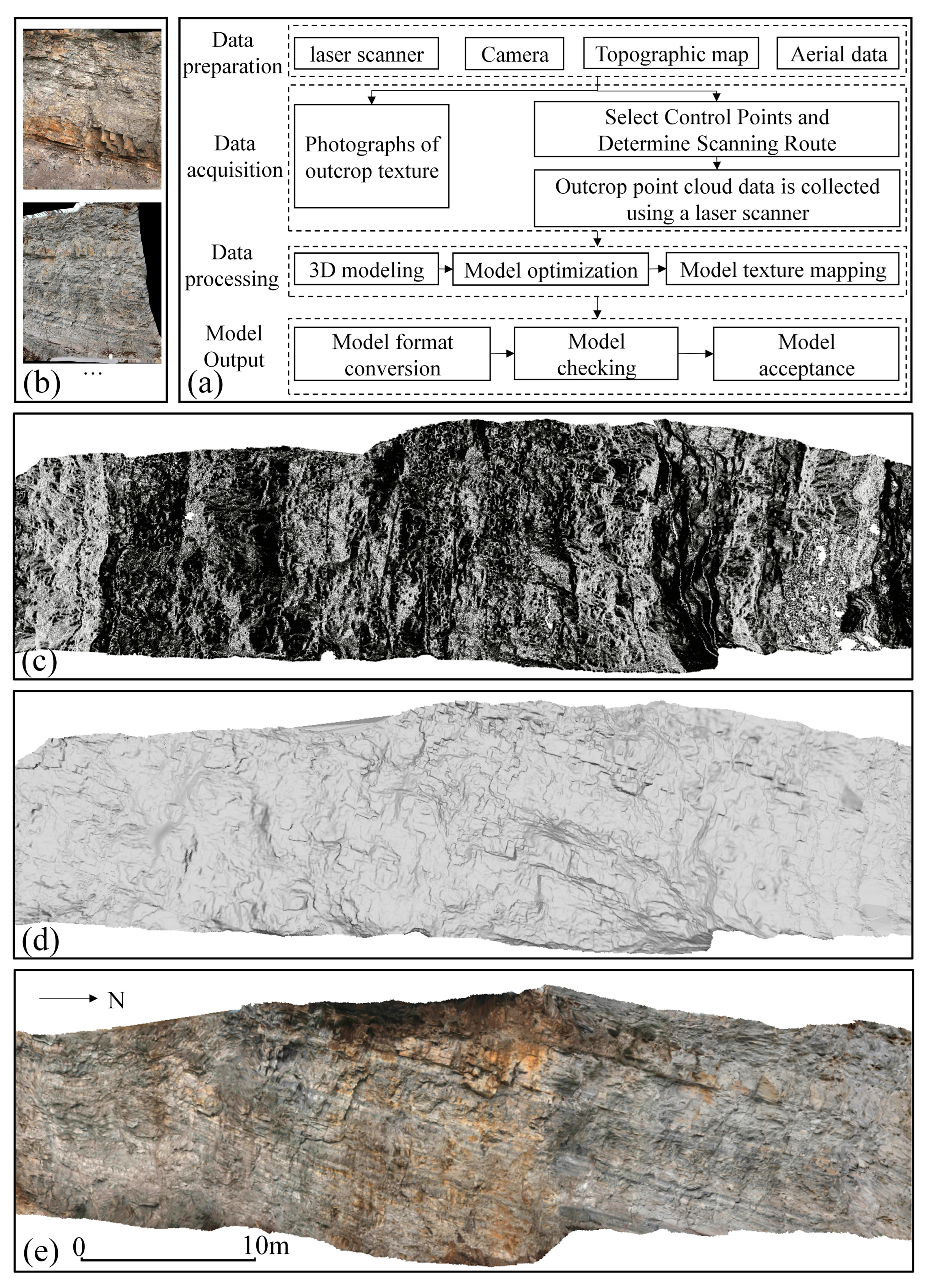

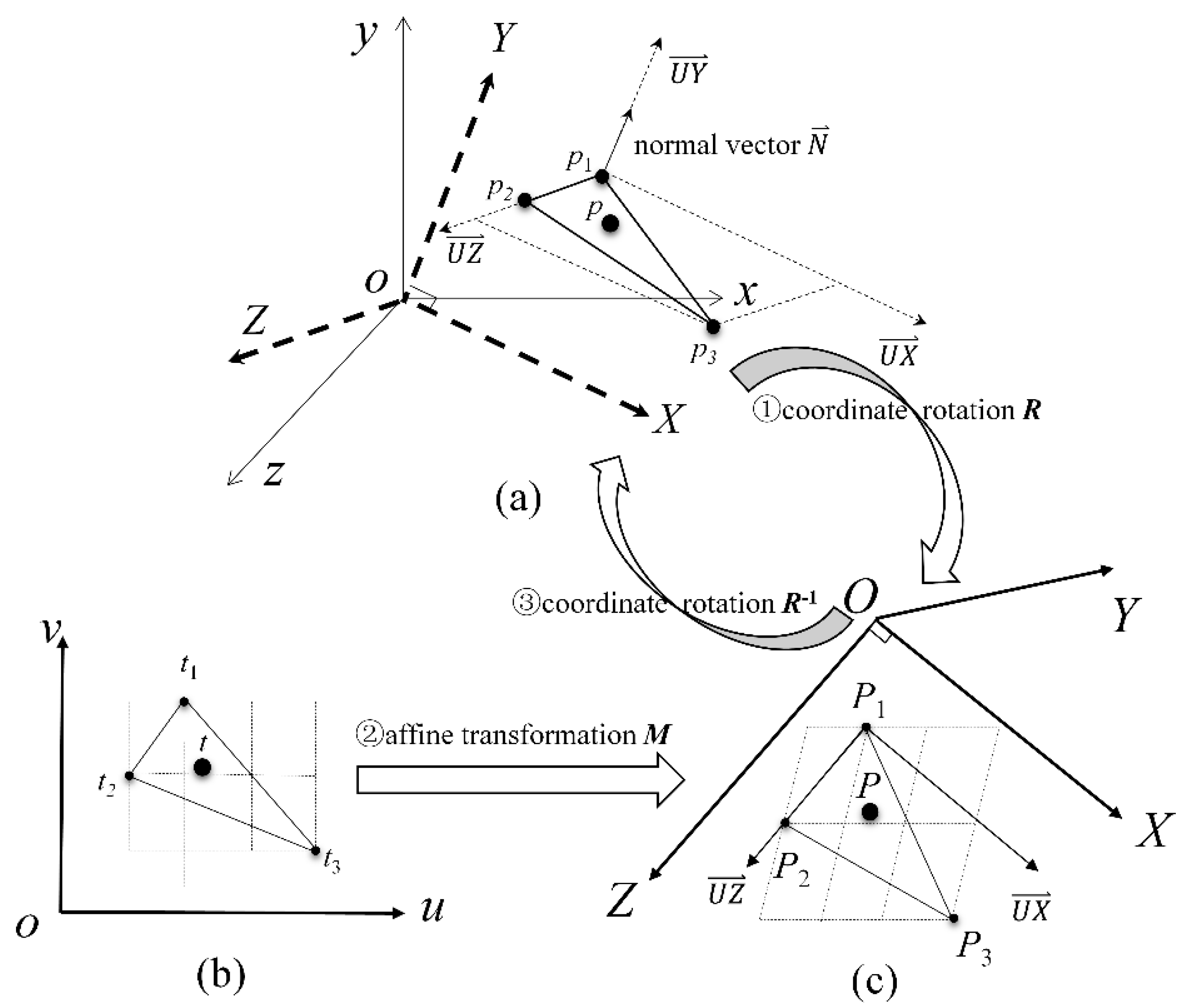

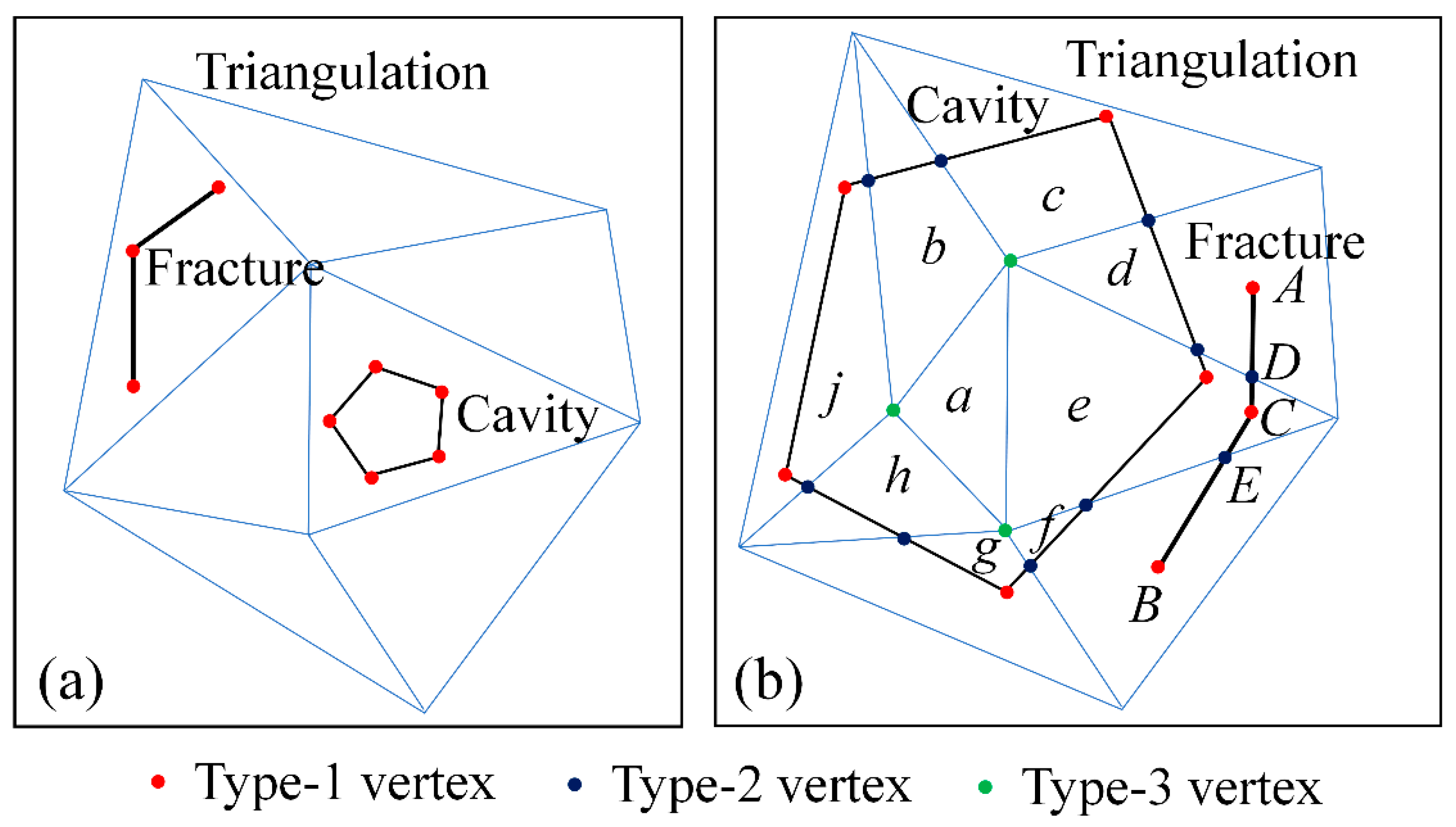
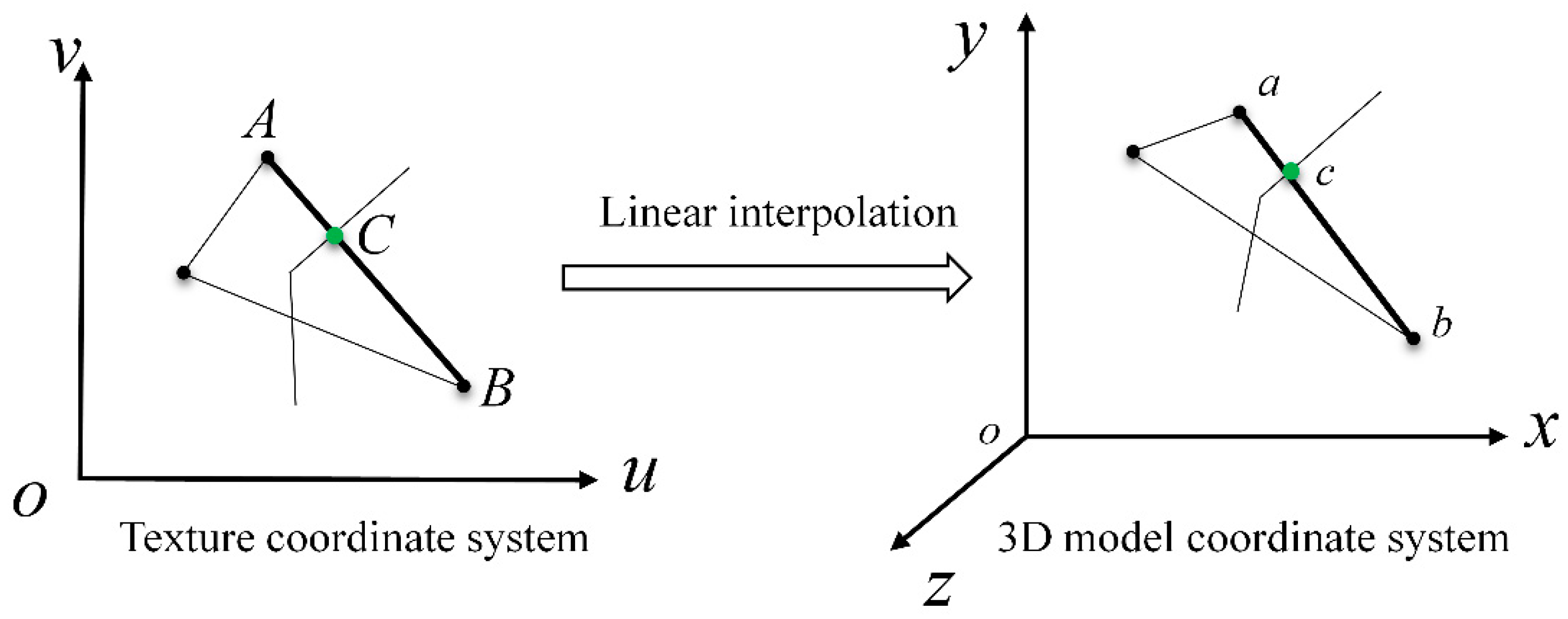

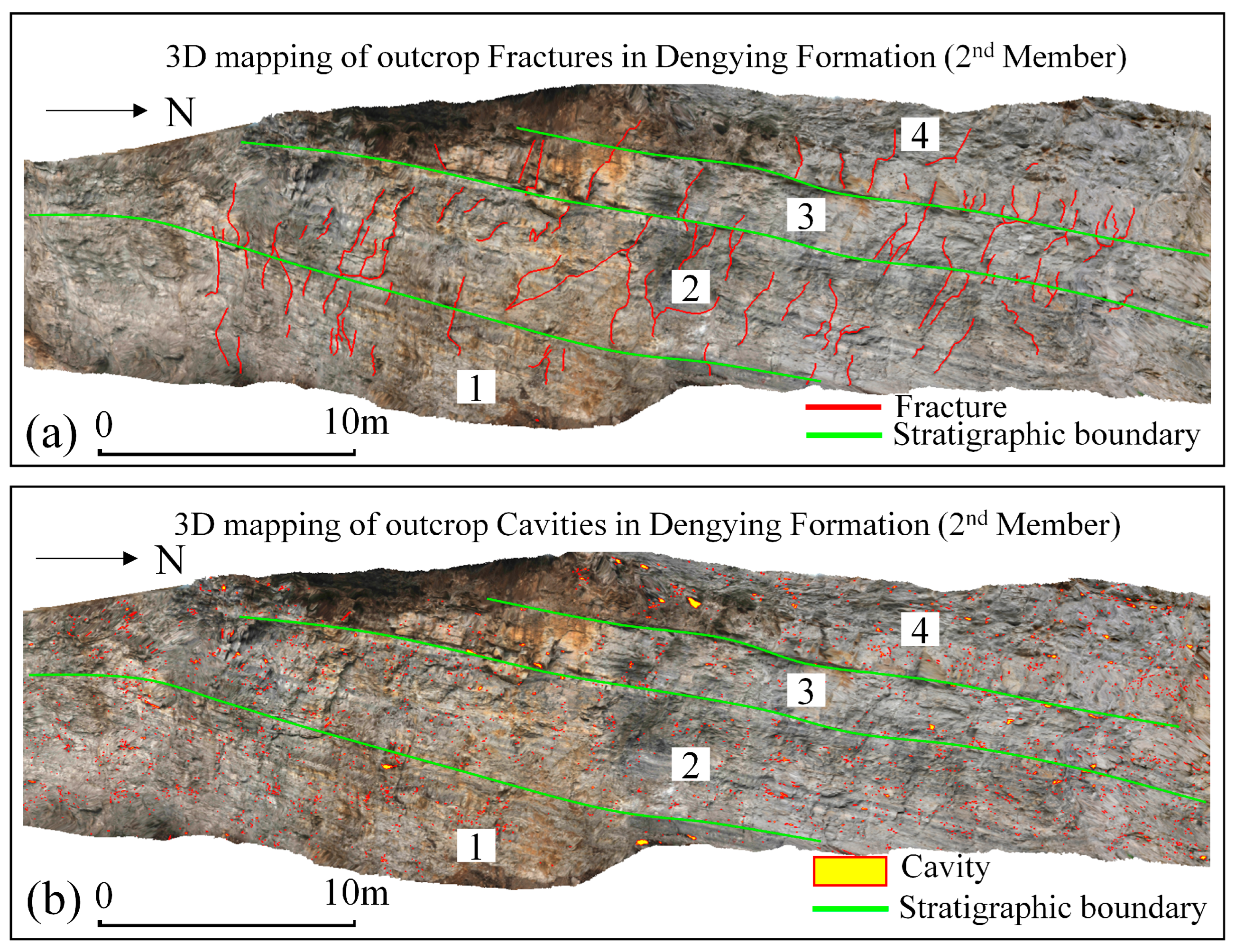
| Layer | Outcrop Area (m2) | Fractures | Cavities | |||||||
|---|---|---|---|---|---|---|---|---|---|---|
| Quantity (Numbers) | Total Length (m) | Average Length (m) | Average Orientation (°) | Density (Numbers/m2) | Quantity (Number) | Total Area (m2) | Average Area (m2) | Surface Porosity (%) | ||
| 1 | 81.77 | 74 | 64.69 | 0.87 | 12.94 | 0.91 | 1996 | 0.46 | 0.000231 | 0.56 |
| 2 | 140.61 | 88 | 131.66 | 1.50 | 17.62 | 0.63 | 3683 | 1.00 | 0.000271 | 0.71 |
| 3 | 58.82 | 61 | 69.17 | 1.13 | 25.21 | 1.04 | 904 | 0.38 | 0.000417 | 0.64 |
| 4 | 62.99 | 38 | 53.67 | 1.41 | 17.29 | 0.60 | 1003 | 0.48 | 0.000476 | 0.76 |
| Total | 344.19 | 261 | 319.19 | 1.22 | 18.02 | 0.76 | 7586 | 2.32 | 0.000306 | 0.67 |
Publisher’s Note: MDPI stays neutral with regard to jurisdictional claims in published maps and institutional affiliations. |
© 2022 by the authors. Licensee MDPI, Basel, Switzerland. This article is an open access article distributed under the terms and conditions of the Creative Commons Attribution (CC BY) license (https://creativecommons.org/licenses/by/4.0/).
Share and Cite
Liang, B.; Liu, Y.; Shao, Y.; Wang, Q.; Zhang, N.; Li, S. 3D Quantitative Characterization of Fractures and Cavities in Digital Outcrop Texture Model Based on Lidar. Energies 2022, 15, 1627. https://doi.org/10.3390/en15051627
Liang B, Liu Y, Shao Y, Wang Q, Zhang N, Li S. 3D Quantitative Characterization of Fractures and Cavities in Digital Outcrop Texture Model Based on Lidar. Energies. 2022; 15(5):1627. https://doi.org/10.3390/en15051627
Chicago/Turabian StyleLiang, Bo, Yuangang Liu, Yanlin Shao, Qing Wang, Naidan Zhang, and Shaohua Li. 2022. "3D Quantitative Characterization of Fractures and Cavities in Digital Outcrop Texture Model Based on Lidar" Energies 15, no. 5: 1627. https://doi.org/10.3390/en15051627
APA StyleLiang, B., Liu, Y., Shao, Y., Wang, Q., Zhang, N., & Li, S. (2022). 3D Quantitative Characterization of Fractures and Cavities in Digital Outcrop Texture Model Based on Lidar. Energies, 15(5), 1627. https://doi.org/10.3390/en15051627







